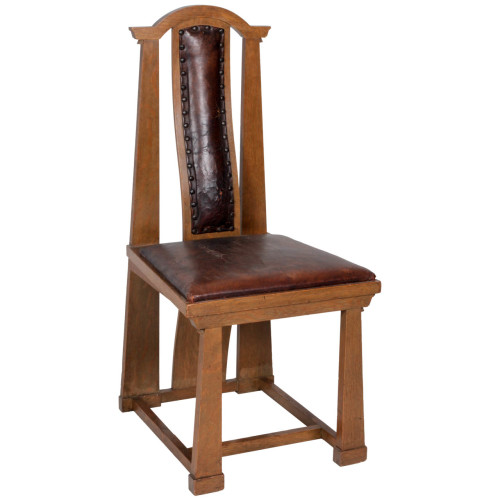Product Description
George Washington Maher “Rockledge” American Arts & Crafts side chair 1911-12
(Gift to The Wolfsonian-FIU, Miami Beach, FL)



George Washington Maher (1864-1926) USA
Rockledge side chair, 1911-1912.
Stained oak with the original leather upholstery and leather-covered tacks.
Provenance: Ernest L. & Grace King residence, Homer, Minnesota
H: 40 ¾” W: 18 ½” x D: 20 ¼”
(Gift to The Wolfsonian-FIU, Miami Beach, FL)
In 1912 George Washington Maher designed Rockledge, a summer residence near Homer, Minnesota, for E.L. King. Sited just beneath a cliff along the Mississippi River, Rockledge is considered the finest residence of Maher’s career and a perfect example of his motif-rhythm theory of architectural design.
Information and other examples from the Maher / Rockledge commission can be found in the following books and publications: The Art that is Life: The Arts and Crafts Movement in America, 1875-1920, ed. Wendy Kaplan, (Boston: Museum of Fine Arts, Boston, Little, Brown and Company, 1987), pp. 396-400,The Ideal Home: The History of Twentieth Century American Craft, 1900-1920, Janet Kardon (New York: Abrams, 1993) cover illus. and p. 205; Geo. W. Maher Quarterly, Oct.-Dec., 1992, pp. 1, 16, 17; Arts, December, 1995, The Minneapolis Institute of Arts, Minneapolis, Minn. cover and back cover.
Examples of artworks from Rockledge are in the permanent collections of The Metropolitan Museum of Art, Cooper-Hewitt National Design Museum, NY, The Brooklyn Museum of Art, The Minnesota Historical Society, The Newark Museum, The Baltimore Museum of Art, The Minneapolis Institute of Arts, The Milwaukee Art Museum, The Wolfsonian, Miami Beach, FL, Dallas Museum of Art, the Houston Museum of Fine Arts and the St. Louis Art Museum.
George Washington Maher “Rockledge” American Arts & Crafts side chair 1911-12
(Gift to The Wolfsonian-FIU, Miami Beach, FL)
CHRISTOPHER DRESSER (1834-1904) UK
MINTON, Stoke-on-Trent, England
“Cloisonné” vase 1867
Glazed porcelain with polychrome enamel decoration and gilding
Marks: MINTON, date cipher for 1867
Illustration: Truth, Beauty, Power: Dr. Christopher Dresser 1834-1904, exhibition catalogue, Historical Design, Inc. (New York, 1998) p. 78.
H: 9 7/8”
